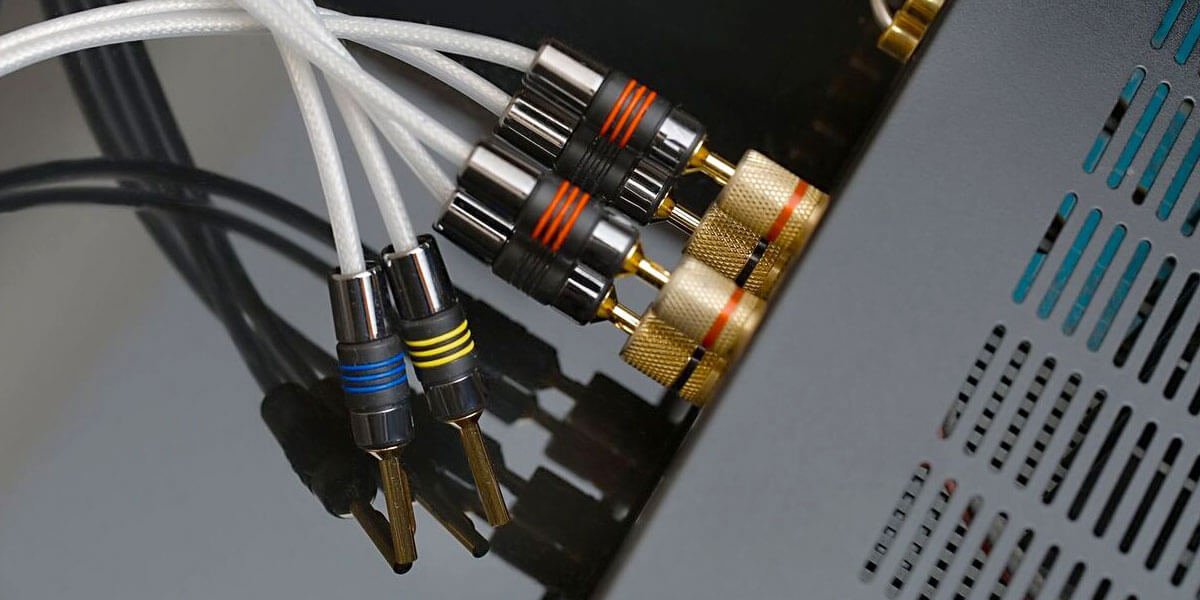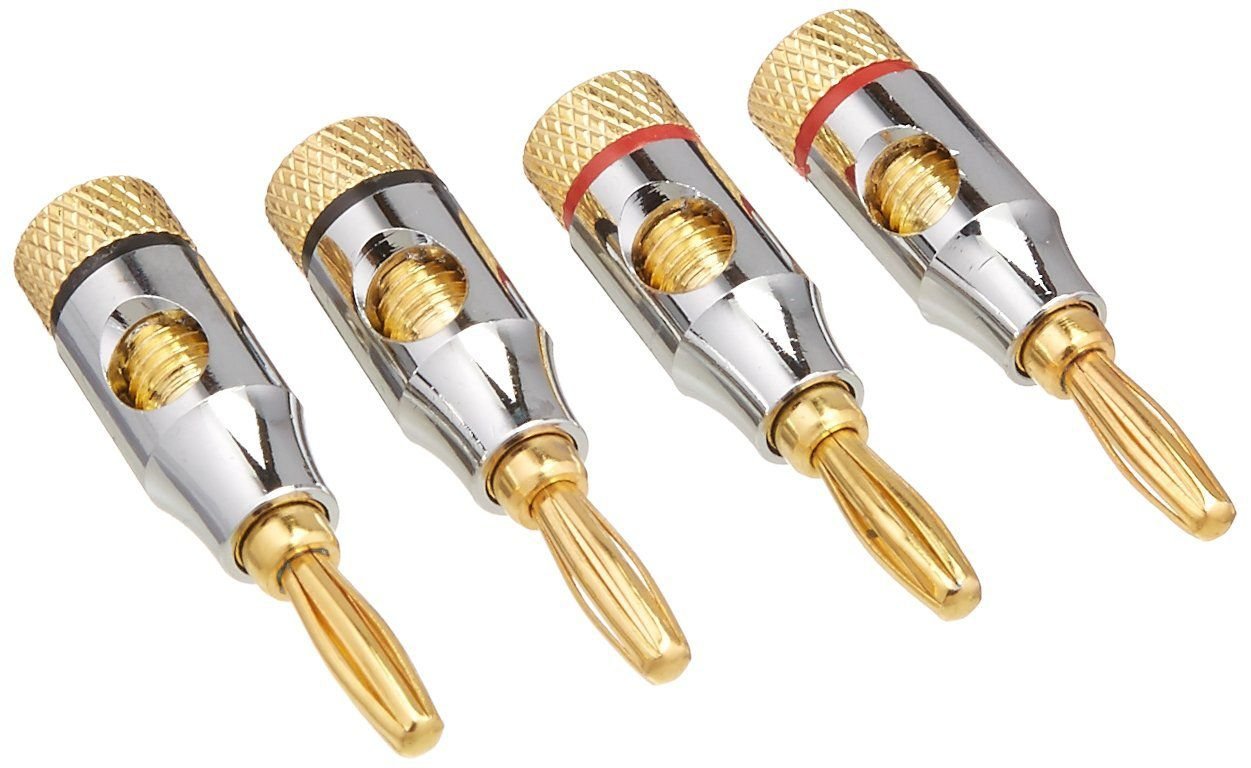1. What is Speaker Wire Connectors
Speaker wire connectors are the component to make the process of connecting your speaker wires easier; also, it will be more efficient for your audio system. They are usually composed of metal and come in a range of shapes and sizes to accommodate various types of speaker terminals.

2. Advantages of Speaker Wire Connectors
1. Improved Connection Quality
- Connectors provide a stable and secure connection, reducing the risk of intermittent signal loss or distortion.
- They minimize oxidation and corrosion, which can degrade sound quality over time.
2. Reduced Wear and Tear on Speaker Terminals
- Frequent reconnections with bare wire can loosen or damage speaker terminals.
- Connectors reduce the stress on terminals, extending the lifespan of your equipment.
3. Ease of Installation and Removal
- Quick plug-and-play setup compared to twisting and securing bare wire manually.
- Helpful for frequent equipment adjustments or repositioning of speakers.
4. Better Cable Management
- Connectors help keep wires organized and tangle-free.
- Neater setups, especially in home theaters or professional audio systems.
5. Enhanced Safety
- Prevents stray wire strands that could cause short circuits.
- Some connectors, like banana plugs, provide insulated casings, reducing the risk of accidental contact.
6. Compatibility with Various Speaker Terminals
- Most connectors work with binding posts, spring clips, and other common speaker inputs.
- Ensures better compatibility with high-end audio equipment.
7. Long-Term Cost Savings
- High-quality connectors can last for years, avoiding frequent replacements.
- Protecting terminals and preventing wire damage reduces maintenance costs.
3. Types of Speaker Wire Connectors

- Spade connectors: Spade connectors feature a forked piece of metal that hugs the collar of a 5-way binding post terminal.
- Banana plugs
- Dual-banana plugs
- Pin connectors
1. Banana Plugs
- Description: Small cylindrical connectors with a spring-loaded metal pin that fits snugly into binding posts on speakers and receivers.
- Pros:
- Easy to plug in and remove
- Provides a secure connection
- Reduces the risk of frayed wires
- Cons:
- May not fit all speaker terminals
- Slightly more expensive than bare wire
2. Spade Connectors
- Description: U-shaped connectors that slide around the binding post and are secured by tightening the post.
- Pros:
- Strong, reliable connection
- Less likely to come loose than banana plugs
- Cons:
- Requires a binding post that supports spades
- Can be difficult to install in tight spaces
3. Pin Connectors
- Description: Thin, cylindrical metal pins that fit into spring-clip terminals on speakers and amplifiers.
- Pros:
- Good for older systems with spring-clip connections
- Easier to insert than bare wire
- Cons:
- Less secure than banana plugs or spade connectors
- Not widely used in modern high-end audio setups
4. Bare Wire
- Description: Simply stripping the insulation off the wire and inserting it directly into the terminal.
- Pros:
- No additional cost for connectors
- Works with almost all speaker terminals
- Cons:
- Can fray and degrade over time
- Harder to maintain a solid connection
5. RCA Connectors
- Description: Common in home theater and powered speaker systems, RCA cables carry both audio signals and power in some setups.
- Pros:
- Often used for subwoofers and powered speakers
- Reduces clutter by combining signal and power
- Cons:
- Not used for traditional passive speakers
- Requires RCA-compatible inputs and outputs
Best type of speaker wire
One of the best conductors is 100% copper, which is the standard for speaker wires and the best choice. Some expensive speaker cables feature oxygen-free copper, specially refined so it doesn’t contract or expand with heat and supposedly offers higher audio performance.
Best wire for Speaker
between 12 and 16 gauge
Speaker wires that are anywhere between 12 and 16 gauge are most commonly used for connecting speakers to an amplifier or an audio/video (A/V) receiver. A lower-gauge number indicates a thicker wire, while a higher-gauge number indicates a thinner wire
4. What is the maximum length of speaker wire?
50 feet
While in theory heavier wire can have longer runs, recommended household audio lengths should not exceed 50 feet (15 m). The gauge numbers in SWG (standard wire gauge) and AWG (American wire gauge) reduce as the wire gets larger. Sizing in square millimeters is common outside of the US.
5. How to Connect Speaker Wires?
Loosen the speaker terminal so that the gap is exposed. Insert the twisted end of the positive speaker wire into the gap on the side of the red speaker terminal. Tighten the terminal. Repeat this process for the negative (black) speaker wire, inserting it into the black speaker terminal.
- Loosen the Speaker Terminal
- Turn the binding post counterclockwise until you see a small gap exposed on the side.
- Prepare the Speaker Wire
- Strip about ½ inch (12mm) of insulation off the end of the speaker wire.
- Twist the exposed copper strands tightly to prevent fraying.
- Insert the Positive Wire (Red Terminal)
- Take the positive (red) speaker wire and insert the twisted end into the hole on the side of the red binding post.
- Ensure a secure connection without loose strands sticking out.
- Tighten the Red Terminal
- Turn the binding post clockwise to clamp down on the wire, ensuring a firm connection.
- Repeat for the Negative Wire (Black Terminal)
- Insert the negative (black) speaker wire into the black binding post and tighten it the same way.
- Double-Check the Connection
- Gently tug on the wires to ensure they are secure.
- Ensure no stray strands are touching other terminals, which could cause a short circuit.
- Test the Speakers
- Power on your system and play audio to confirm the connection is working properly.
Conclusion
Choosing the right speaker wire connector is essential for achieving a secure and high-quality audio connection. While bare wire is a cost-effective option, using banana plugs, spade connectors, or pin connectors enhances durability, ease of installation, and sound reliability.
For home theaters and high-end audio systems, banana plugs offer the best balance of convenience and performance.



